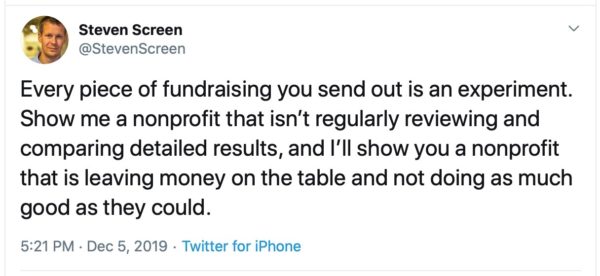I tweeted this out last month, and it got a lot of love (well, for me anyway):

You ran a bunch of fundraising experiments in 2019 – have you learned everything you can learn from them?
And the appeals, e-appeals, and newsletters you sent out are not the only experiments you ran. Your whole fundraising program is an experiment. Your major donor program is an experiment. Your direct response program is an experiment.
Here are some example questions, and what they attempt to measure:
- What percentage of your donors did you retain in 2019 versus previous years? This will help you know, overall, how well your fundraising program performed last year.
- What percentage of your major donors did you retain in 2019 versus previous years? This will tell you how good your program is at retaining major donors – you know, your most important group of donors. Want to really get into the data? Measure the amount of major donor revenue you retained. That will show you if you’re retaining your highest value donors (which is best). Or if you’re just replacing lost revenue with new revenue each year. (H/T to Veritus Group for popularizing this idea.)
- Of your appeal letters, which one had the highest net revenue? Which one had the highest response rate? These will help you answer which appeals you should ‘repeat’ and do again this year – and which ones you should not do again this year.
- For each mailing, what’s your response rate by recency? For instance, if you send your appeals to all donors who have given a gift in the last 24 months, what’s the response rate and net revenue from the 18-24-month group? That will tell you whether you should continue to mail to those donors.
With the answers to questions like these, you can make the types of changes that smart organizations use to raise more money every year.
And if you make all the needed changes to the best of your ability, it’s like compound interest. 1 + 1 + 1 = 5. That’s where organizations see the big growth.
And it’s basically free money! It’s just measuring experiments that you’ve already run and using data to make your 2020 fundraising decisions.
Instead of “Hindsight is 2020,” I propose “Use hindsight in 2020!”

